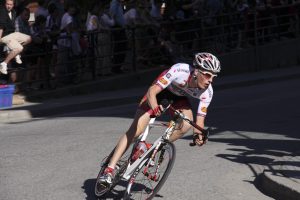There is a big difference between cycling straight ahead and taking a turn. In order to cycle straight ahead, we only have to keep our bicycle upright, because then we automatically go straight on. Moreover, keeping our bicycle upright is very easy when that bicycle is moving. This part of the website explains how we steer through a turn. The verb “steer” may give the false impression that it is only about effectively changing direction. A longer but better formulation is “determining, preparing and executing a change of direction”. This long name is better because it emphasizes the importance of (1) collecting and processing visual information and (2) preparing the movement that initiates the change of direction.

We need our eyes to change direction. We do not need them to cycle straight ahead, although they do help a bit. After all, we will go straight ahead if we keep our bicycle upright, and we only need our vestibular organ for that. For two reasons visual information is essential when we take a turn: (1) we need to know where the turn begins so that we know where to initiate steering, and (2) we need to know how sharp the turn is so that we know how much we have to tilt the bicycle inwards. There are two types of visual information on the basis of which we determine where and how we initiate steering. First, our brain uses the objects at the place where we want to go (roadside, road markings, lampposts, fellow road users, …), and translates that visual information into movements (steering impulses and body movements) with which we arrive at place. Second, our brain also uses the movement of the (stationary) environment in relation to the moving cyclist, and also translates that information into movements. It is important to separate those two types of visual information.

Not only the type of visual information is important for the cyclist, but also how he arrives at that information. In other words, where does the cyclist look before and during the turn? To get an idea of this, it is useful to study the viewing behavior of professional cyclists and motorcyclists. This viewing behavior is surprisingly well matched with the insights from science: from both perspectives (the actual viewing behavior of professionals and a scientific analysis) follows the advice “Look at the place where you want to go!” In scientific terms, “Look at your movement target“.
There are three different ways of looking through a turn: turning your eyes in your head, turning your head on your torso, and turning your torso on your lower body. Professionals always turn (also) their heads.
Finally, there is always some time between selecting a target (eg, driving right or left along a pole) and the movements with which we achieve that goal. That is why the preparation of our movements is so important, and this is especially so when we cycle at high speed and when we have to change direction quickly. The preparation of movements is a function of the prefrontal cortex, and there is good evidence that the cerebellum helps the prefrontal cortex to automate it.